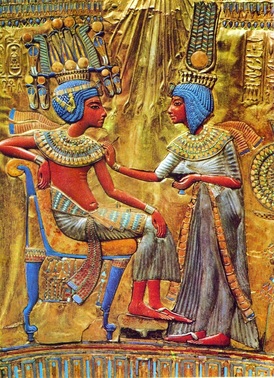The Life of King Tut
Tutankhamun ruled Egypt between 1224 and 1235 BC. He was most likely the 12th
ruler of Egypt's 18th Dynasty. The young pharaoh was born with the name Tutankhaten, to celebrate the monotheistic religion founded by his father Ankhenaten.
At the end of Ankhenaten's reign, the king's advisors, Ay and Horemheb, realized that the people would not want to support his new religion. When he died, they had the young king, who was nine years old, crowned in the old capital of Memphis. Since Tut had no living female relatives old enough, he was probably taken care of by Ay or Horemheb or both, who would have acted as the real ruler of Egypt.
Soon after Tutankhamun became pharaoh, Ay and Horemheb made an order to return to Egypt's traditional religion. By year two of his reign, he changed his name, removing the "aten" and replacing it with "amun".
Interestingly, Tutankhamun was not listed on the official Egyptian king's list, probably because Horemheb, who later became pharaoh, took credit for most of his work. This includes the return of the old religion of Amun and the reopening and rebuilding of the temples. The inscriptions on important statues were also changed to credit Horemheb, even though they pictures of King Tut. Even the building carried out at the temples of Karnak and Luxor were claimed by Horemheb. Because of this, many historians knew little about King Tut's rule until his tomb was found in 1922.
Not much happened militarily during Tutankhamun's short time as pharaoh. There were scenes of the king hunting in the desert and fighting Nubians and Syrians found in Tut's tomb. But, it is unlikely that Tutankhamun actually took part in the military actions directly, because he was so young.
Though we know that Tutankhamun died at an early age, no one is certain about how he died. Analysis of his mummy shows that he died around age 18. Many theories have been proposed including that he was murdered, died of an infection from a badly broken leg or from some type of disease. It may be one of the great mysteries of history that no one will ever truly know.
ruler of Egypt's 18th Dynasty. The young pharaoh was born with the name Tutankhaten, to celebrate the monotheistic religion founded by his father Ankhenaten.
At the end of Ankhenaten's reign, the king's advisors, Ay and Horemheb, realized that the people would not want to support his new religion. When he died, they had the young king, who was nine years old, crowned in the old capital of Memphis. Since Tut had no living female relatives old enough, he was probably taken care of by Ay or Horemheb or both, who would have acted as the real ruler of Egypt.
Soon after Tutankhamun became pharaoh, Ay and Horemheb made an order to return to Egypt's traditional religion. By year two of his reign, he changed his name, removing the "aten" and replacing it with "amun".
Interestingly, Tutankhamun was not listed on the official Egyptian king's list, probably because Horemheb, who later became pharaoh, took credit for most of his work. This includes the return of the old religion of Amun and the reopening and rebuilding of the temples. The inscriptions on important statues were also changed to credit Horemheb, even though they pictures of King Tut. Even the building carried out at the temples of Karnak and Luxor were claimed by Horemheb. Because of this, many historians knew little about King Tut's rule until his tomb was found in 1922.
Not much happened militarily during Tutankhamun's short time as pharaoh. There were scenes of the king hunting in the desert and fighting Nubians and Syrians found in Tut's tomb. But, it is unlikely that Tutankhamun actually took part in the military actions directly, because he was so young.
Though we know that Tutankhamun died at an early age, no one is certain about how he died. Analysis of his mummy shows that he died around age 18. Many theories have been proposed including that he was murdered, died of an infection from a badly broken leg or from some type of disease. It may be one of the great mysteries of history that no one will ever truly know.

